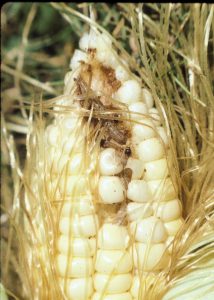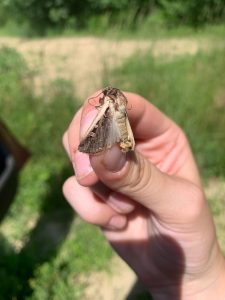Sweet Corn IPM Newsletter No. 6 — August 4, 2023
CORN EARWORM, ARMYWORM MOTH COUNTS LOWER
Western Bean Cutworm Moth Counts Remain High
SITUATION
Early planted corn is being harvested in much of the state this week. Maturity has been uneven in many fields due to rain and the resulting fertility issues. Pesticide application continues to be challenging for most growers due to very wet soils, and rain washing off recent applications. Moth captures in pheromone traps were generally lower this week, perhaps due to much cooler night temperatures reducing activity. However, western bean cutworm moth counts remain high at most locations and may threaten silking corn.

European corn borer: While larval feeding in pre-tassel corn increased in some fields this week, all were under threshold when measured by corn borer feeding alone. However, most fields also had feeding injury from corn earworm and/or fall armyworm, which put them over the control threshold of 15% injury. Moth counts also remained low at nearly all sites this week. The first generation of European corn borer usually starts to decline in midsummer. Occasionally we see a partial second generation emerge in September.
Corn earworm: Moth numbers were lower at most locations this week. However, we continue to see earworm feeding on whorl to pre-tassel plants, suggesting that this insect is still active in many fields. Based on this week’s moth counts, a 4-day spray interval for silking corn was recommended for Auburn, and one Wells site. A 5-day spray schedule was recommended for Cape Elizabeth, Lewiston, Wayne and one Wells site. A 6-day spray interval was recommended for Biddeford and Garland. There have been concerns throughout the Northeast that pheromone traps may not be accurately representing moth populations in the field, likely due to the very wet, and variable weather. As a result, a more cautious approach to protecting corn may be considered. For example, applying at least one protective spray at pre-tassel and another when silks first appear, especially if larvae are present in the field, regardless of pheromone trap catches.
Fall armyworm: Moth counts remain relatively low, with the exception of one site in Biddeford which was over the three moth threshold for silking corn. Low levels of larval feeding damage were found in some pre-tassel corn, but not over threshold at any location.

Western Bean Cutworm: Moth numbers remained high this week, ranging from 5 to 60 at our trapping sites. While there are no specific thresholds for western bean cutworm moths in silking corn as there are for fall armyworm and corn earworm, they do behave very similarly to these species, so it is advisable to keep silking corn protected at this time, even if traps are catching very few earworm and/or armyworm. The threshold for feeding injury on plants is 8%. The optimal time for controlling the larvae is late pre-tassel to tassel.
Squash vine borer: Moth counts remain high at all locations this week. Nearly all sites were over the five moth threshold and sprays are recommended for all pumpkins and susceptible winter and summer squash types.
Sincerely,
David T. Handley
Vegetable & Small Fruit Specialist
Highmoor Farm
P.O. Box 179
52 U.S. Route 202
Monmouth, ME 04259
207.933.2100
UMaine Extension Diagnostic Research Lab
Pest Management Unit
17 Godfrey Drive
Orono, ME 04473
1.800.287.0279
| Location | CEW Moths | ECB Moths | FAW Moths | %Feeding Damage | Recommendations / Comments |
|---|---|---|---|---|---|
| Auburn | 9 | 1 | 0 | 3% | 4-day interval recommended for silking corn |
| Biddeford | 2 | 0 | 6 | 6% | 6-day interval recommended for silking corn |
| Bowdoinham | 0 | 0 | 0 | 6% | No spray recommended |
| Cape Elizabeth | 5 | 0 | 0 | 5% | 5-day interval recommended for silking corn |
| Dayton | 0 | 0 | 0 | 0% | No spray recommended |
| Farmington | 0 | 0 | 0 | 10% | No spray recommended |
| Garland | 3 | 0 | 0 | 1% | 6-day interval recommended for silking corn |
| Hollis | 1 | 1 | 0 | 5% | No spray recommended |
| Lewiston | 7 | 0 | 0 | 3% | 5-day interval recommended for silking corn |
| Monmouth | 0 | 0 | 1 | — | No spray recommended |
| New Gloucester | 1 | 0 | 0 | 0% | No spray recommended |
| Oxford | 0 | 0 | 0 | 4% | 5-day interval recommended for silking corn |
| Palmyra | 0 | 1 | 0 | 0% | No spray recommended |
| Wayne | 4 | 0 | 0 | 0% | 5-day interval recommended for silking corn |
| Wells I | 8 | 0 | 1 | 10% | 4-day interval recommended for silking corn |
| Wells II | 4 | 1 | 1 | 0% | 5-day interval recommended for silking corn |
CEW: Corn earworm (Only fresh silking corn should be sprayed for this insect.)
ECB: European corn borer
FAW: Fall armyworm
| Moths caught per week | Moths caught per night | Spray Interval |
|---|---|---|
| 0.0 to 1.4 | 0.0 to 0.2 | No spray |
| 1.5 to 3.5 | 0.3 to 0.5 | Spray every 6 days |
| 3.6 to 7.0 | 0.6 to 1.0 | Spray every 5 days |
| 7.1 to 91 | 1.1 to 13.0 | Spray every 4 days |
| More than 91 | More than 13 | Spray every 3 days |
Thresholds apply only to corn with exposed fresh silk. Lengthen spray intervals by one day if maximum daily temperature is less than 80°F.
European Corn Borer Thresholds
Whorl stage: 30% or more of plants scouted show injury.
Pre-tassel-silk: 15% or more of plants scouted show injury.
Silk: 5 or more moths caught in pheromone traps in one week.
IPM Web Pages:
Explore Integrated Pest Management in Maine — UMaine
Integrated Pest Management Data Visualization Tool — Penn State
Integrated Pest Management — UMass Amherst
Where brand names or company names are used, it is for the reader’s information. No endorsement is implied nor is any discrimination intended against other products with similar ingredients. Always consult product labels for rates, application instructions and safety precautions. Users of these products assume all associated risks.
The University of Maine is an equal opportunity/affirmative action institution.
